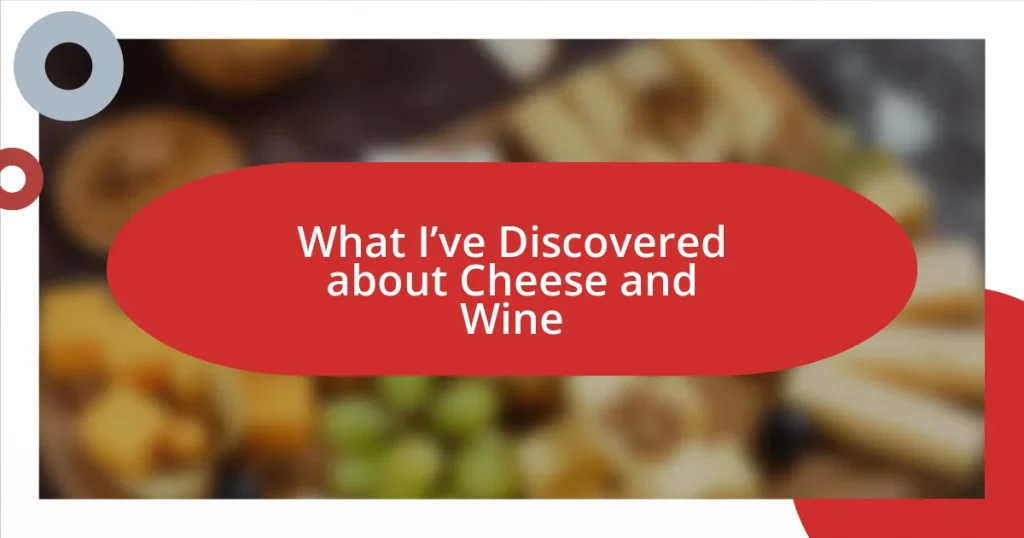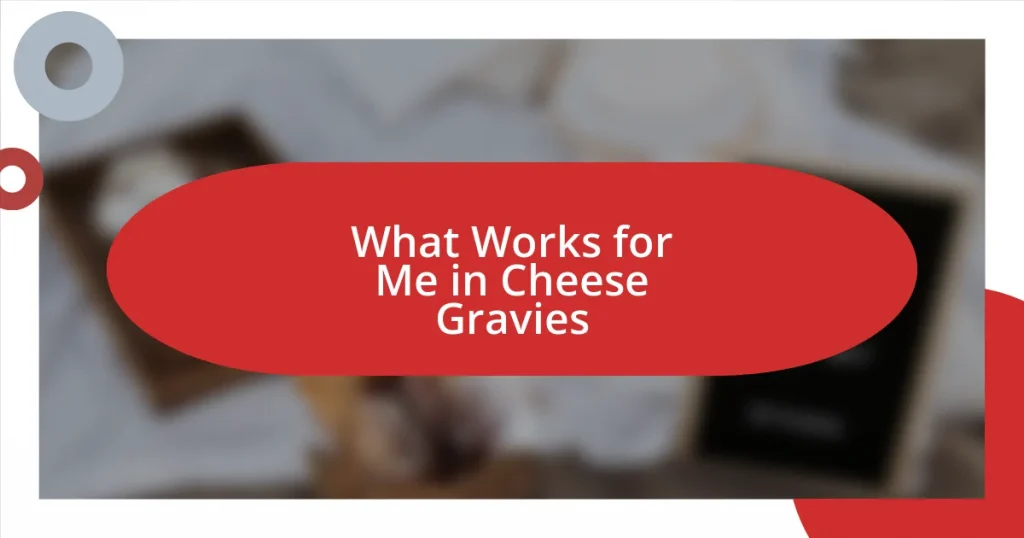Key takeaways:
- Understanding flavor profiles, such as acidity, sweetness, and texture, is essential for creating successful cheese and wine pairings.
- Regional pairings, where local cheeses and wines complement each other, enhance the tasting experience and evoke memories of specific places.
- Common mistakes to avoid include mismatching bold cheeses with delicate wines, overlooking texture, and not serving cheese and wine at the appropriate temperatures.
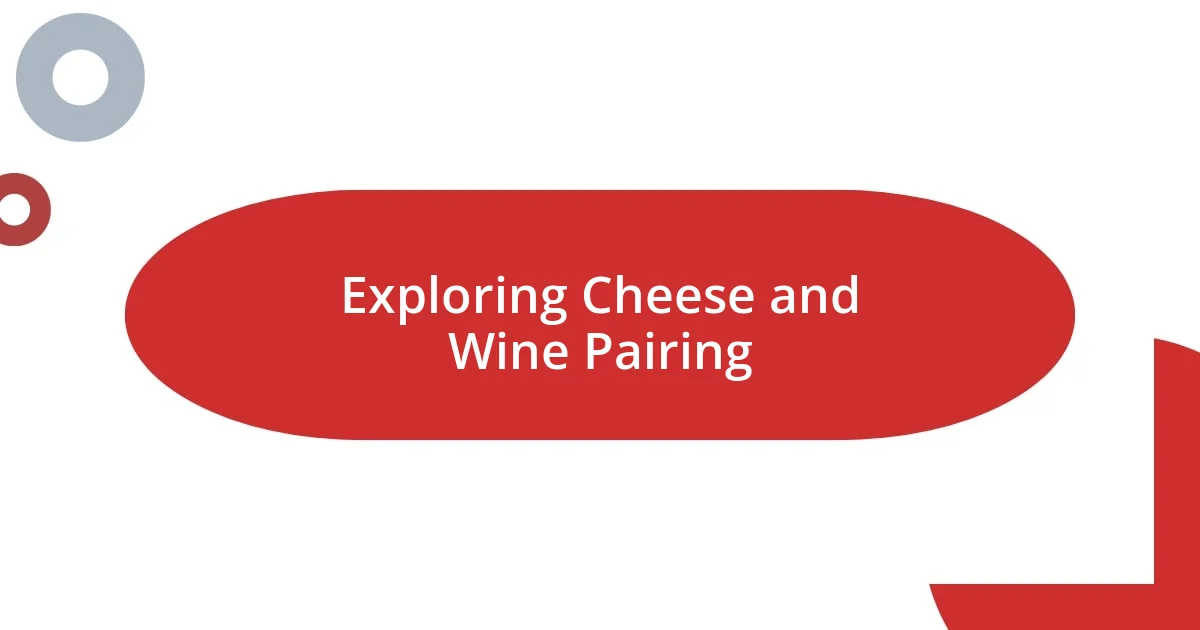
Exploring Cheese and Wine Pairing
When I first ventured into the world of cheese and wine pairing, I was overwhelmed by the endless combinations. I remember sitting at a rustic table with friends, sampling a rich, creamy brie alongside a crisp Chardonnay. The way the flavors danced together sparked an epiphany—how can such simple ingredients transform a gathering into a memorable experience?
Often, it’s the contrast in flavors that creates magic on our palates. Take, for example, a sharp aged cheddar paired with a bold Cabernet Sauvignon; the rich tannins of the wine somehow seem to elevate the cheese’s nuttiness. I can still recall the moment when I took my first bite and sip together—an instant burst of flavor made me appreciate just how well thought-out pairings can enhance our enjoyment of food.
As I’ve delved deeper into this fascinating pairing adventure, I’ve learned that there are no strict rules, just guidelines. For instance, softer cheeses like goat cheese pair beautifully with fruity and aromatic white wines. Have you ever tried this combination at a picnic? There’s something so satisfying about biting into a tangy cheese while sipping a refreshing Sauvignon Blanc, finding delight in each perfect match.
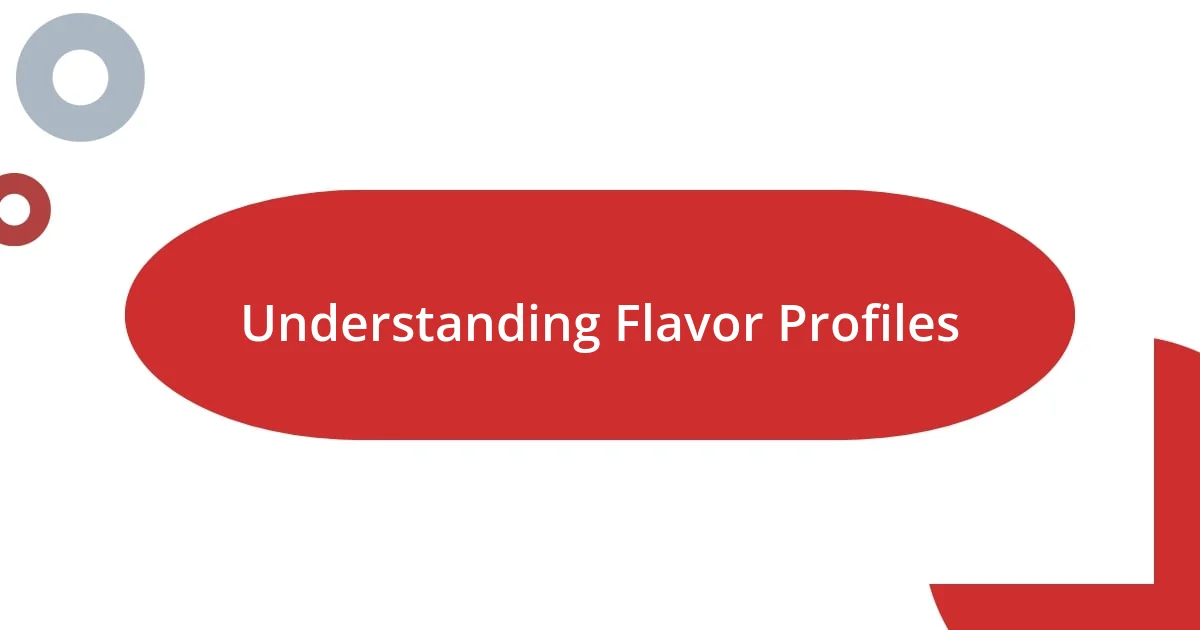
Understanding Flavor Profiles
Understanding flavor profiles is crucial when pairing cheese and wine. I’ve learned that each cheese has its own distinct characteristics that can influence the overall tasting experience. For instance, when I tasted a blue cheese paired with a sweet dessert wine, the contrast created a harmony that made each bite feel like a little celebration.
Here are some key flavor profile considerations to keep in mind when exploring cheese and wine pairings:
- Acidity: A bright, acidic wine can cut through creaminess, balancing rich cheeses.
- Sweetness: Sweet wines can soften the sharpness of aged cheeses, enhancing their depth.
- Body: A full-bodied wine can match the intensity of strong, flavorful cheeses.
- Texture: Consider the texture of both the cheese and wine; a velvety cheese pairs well with a smoother wine.
- Earthiness: Earthy cheeses, like aged Gruyère, often partner beautifully with earthy, oaked wines.
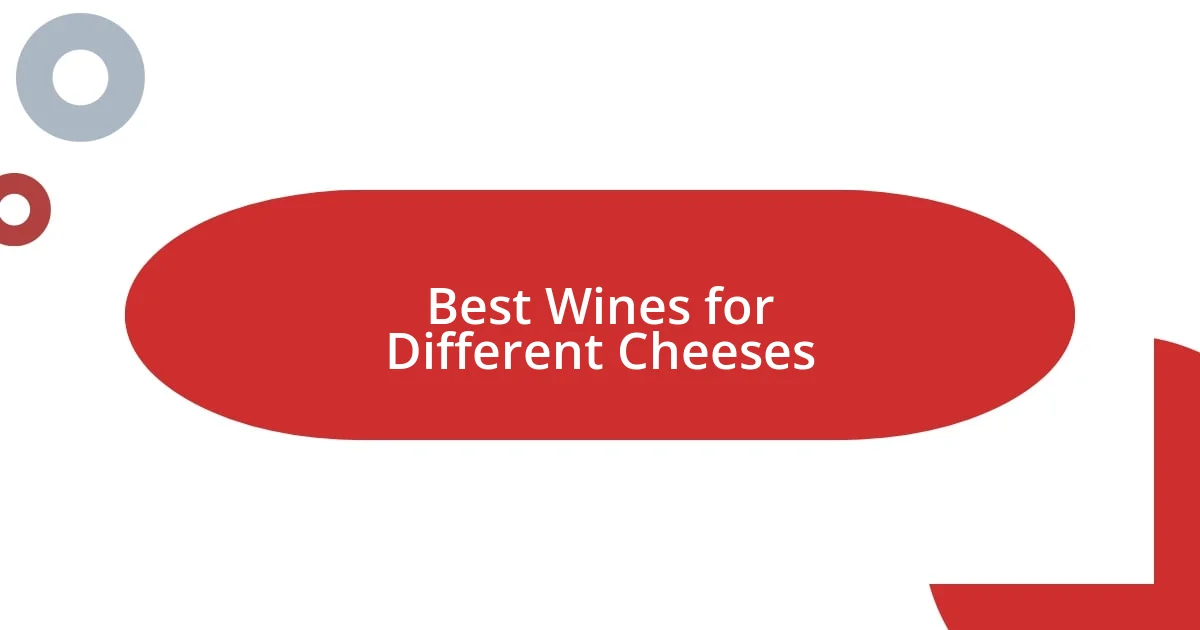
Best Wines for Different Cheeses
When it comes to pairing wine with cheese, I’ve discovered that it’s often about creating balance. For example, a tangy goat cheese with herbs can shine alongside a light Riesling. I fondly remember a summer evening where this pairing took center stage, elevating the entire meal. Each sip of the wine, refreshing and slightly sweet, complemented the creamy texture of the cheese perfectly—an experience that felt like a delicious dance.
On the other hand, bold cheeses like Roquefort deserve robust partners. I’ve found that full-bodied reds, such as a Malbec, can enhance the intense flavors of blue cheeses. I still recall savoring this combination at a friend’s dinner party; the way the wine’s richness enveloped the pungency of the cheese was nothing short of delightful. It’s moments like these that remind me of the magic in thoughtful pairings.
Additionally, I’ve learned that pairing mild cheeses, like fresh mozzarella, with a crisp Pinot Grigio can be a revelation. During a picnic last fall, I paired these two, and the freshness of the wine highlighted the delicate flavors of the cheese beautifully. These experiences continually reinforce my belief that whether you’re at a dinner party or enjoying a quiet night in, the right wine can transform cheese into something truly special.
| Cheese Type | Best Wine Pairing |
|---|---|
| Brie | Chardonnay |
| Aged Cheddar | Cabernet Sauvignon |
| Goat Cheese | Riesling |
| Blue Cheese | Malbec |
| Fresh Mozzarella | Pinot Grigio |
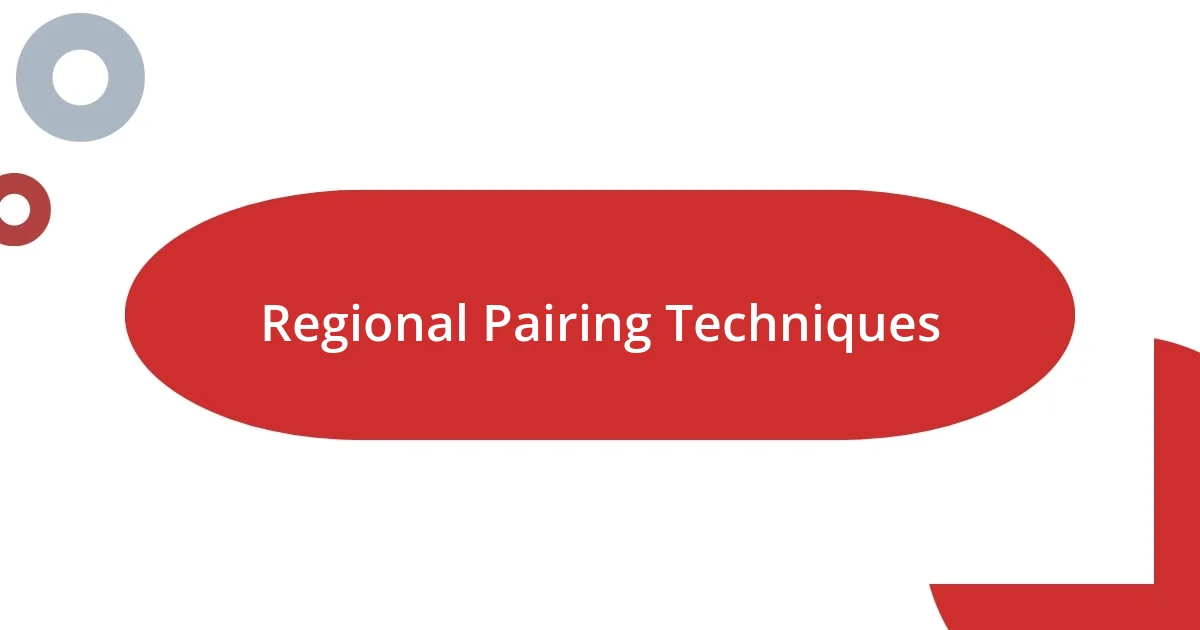
Regional Pairing Techniques
Regional pairing techniques have always intrigued me, especially when you consider how local flavors complement one another. I once traveled through the Italian countryside and discovered that the local Pecorino cheese paired beautifully with a Chianti. It was astonishing to see how the wine captured the essence of the landscape, creating a connection that took me back to that sun-drenched vineyard. Have you ever experienced a pairing that transported you to a different place?
In Provence, the blend of goat cheeses with local rosé made for a charming al fresco lunch overlooking lavender fields. The cheese had a tartness that paired delightfully with the wine’s soft fruit notes, making each nibble feel like a sunny embrace. I remember relishing that moment, surrounded by friends, laughter ringing in the air—it highlighted how regional pairings not only celebrate local produce but also create lasting memories.
There’s something magical about pairing cheeses and wines from the same region, as they often enhance each other’s qualities. I’ve found that robust blue cheeses from France go remarkably well with a good Port; the richness of the cheese absorbs the sweetness of the wine, creating an indulgent experience. The first time I tried this combination at a cozy little wine bar, I felt as though I’d stumbled upon a hidden gem of flavors that perfectly embodied the spirit of the region. Isn’t it interesting how the right pairing can evoke such warmth and intimacy?
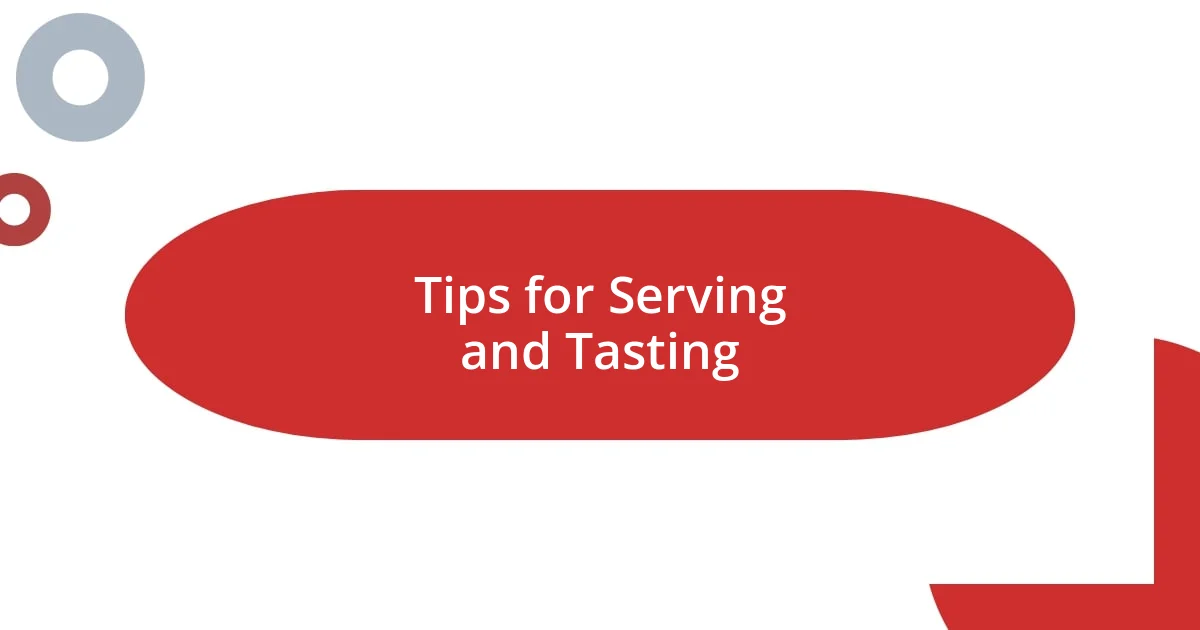
Tips for Serving and Tasting
When serving cheese and wine, I highly recommend letting both sit at room temperature for a while before indulging. It might seem simple, but allowing cheeses to soften enhances their flavors, while a slightly chilled wine presents a more vibrant profile. I vividly recall the first time I served a Brie straight from the fridge; the flavor just fell flat. It wasn’t until I let it warm up that its creamy richness truly emerged, almost like it was waiting for its moment to shine.
Presentation matters, too. I enjoy arranging a cheese board with a variety of textures and colors. It creates not just a feast for the palate but also for the eyes! I remember hosting a holiday gathering where I included everything from sharp Cheddar to tangy goat cheese, garnishing them with fresh herbs and dried fruits. The vibrant colors brought conversations alive, as guests eagerly shared their favorites and swapped pairing ideas. It’s moments like these that showcase the communal aspect of enjoying cheese and wine.
Lastly, don’t hesitate to taste as you go. I’ve often found myself experimenting on the spot, trying a slice of Gouda with a splash of Zinfandel, and discovering a delightful surprise. Have you ever taken a leap and found a combo so delicious, you felt compelled to jot it down? Sharing those kernels of discovery with friends transforms tasting into an adventure, making each gathering not just a meal but a shared experience full of laughter and spontaneity. It’s about the joy found in exploration, don’t you think?

Common Pairing Mistakes to Avoid
One of the most common mistakes I’ve seen is serving bold cheeses with delicate wines. I remember a friend once paired a pungent Roquefort with a light Sauvignon Blanc, and the clash was jarring. It’s crucial to find harmony; robust cheeses crave robust wines, while delicate cheeses sing alongside lighter options. Wouldn’t you agree that balance is key in creating a satisfying experience?
Another pitfall is overlooking the influence of texture. I experienced this firsthand when I matched a creamy Camembert with a super tannic Cabernet Sauvignon. The tannins clouded the lovely flavors of the cheese, masking its lusciousness. Texture plays a significant role in how flavors interact, so always aim for a balance between rich wines and creamy cheeses. It really enhances the experience when you discover the right combination, doesn’t it?
Lastly, I’m often surprised by how many forget about temperature in their pairings. One evening at a wine and cheese tasting, I tried a chilled Chardonnay with a perfectly warm Brie, and it was a missed opportunity. Serving cheese at the right temperature brings out its character while the temperature of the wine can heighten its flavors. Does it surprise you how much these simple factors can impact your tasting experience? Just a slight adjustment can turn a decent pairing into something truly memorable!










